Today’s business environment is characterized by fierce competition, high uncertainty, continuous changes that occur very sudden and quickly, and is fragmented, meaning that an organization by itself cannot influence the industry where it operates. In this difficult environment organizations strive to survive by acquiring competitive advantage. There are a lot of ways to do that, but a very promising one is by improving the decision-making processes to become more efficient and more effective. A scientific decision-making process is presented in the figure below:
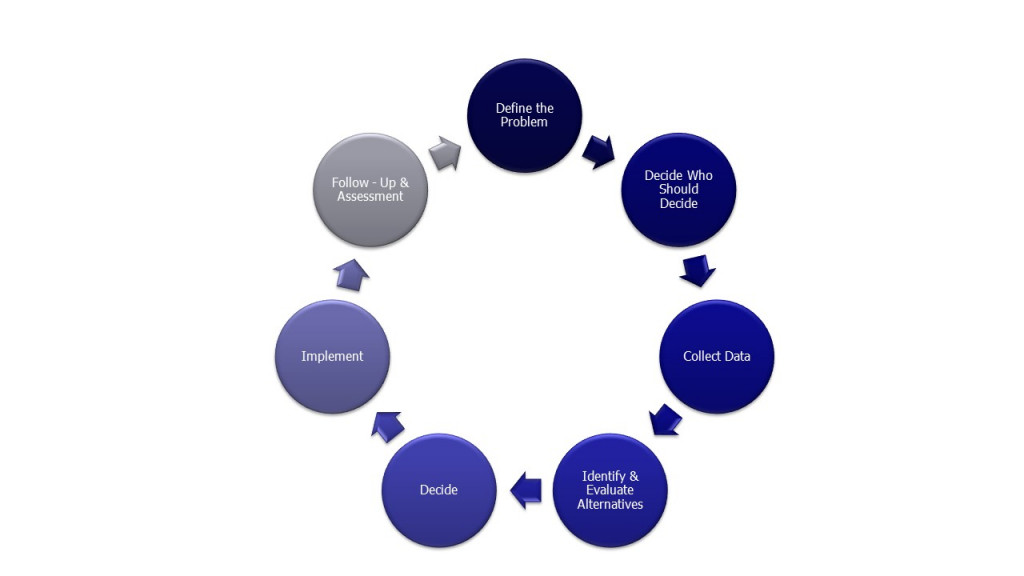
Figure 1: The Scientific Decision-Making Process
For executives to complete all the steps presented in the above figure, they must have access to data. Fortunately, we are living in a data flooded world. According to Statista (2023), a global data and business intelligence platform, it is estimated that the volume of data created, captured, copied and consumed worldwide will reach 181 zettabytes in 2025. Although the data is there waiting for data exploitation, not all of it is useful and hence a difficult selection process must be implemented. Moreover, a very large amount of it is dirty, unstructured, outdated, duplicated, and difficult to access since it is scattered around in a huge number of repositories and not all of it is accessible due to GDPR and other relevant legislations. Also, business executives often lack the skills and the expertise to initiate and manage data exploitation projects and there is a big shortage of qualified analysts to exploit the available data and gain insights out of it. Based on the data explosion of today’s environment, the definition of big data that has arisen incorporates the five V’s, i.e., Velocity, Volume, Variety, Veracity and Value. According to SAS (2021), the point above which data can be characterized as big is when the previously mentioned five V’s exceed an organization’s storage and computation capacity for accurate and timely decision making.

Figure 2: Big Data
(Adapted from the slides of the on-line course “Data Analytics for Managers” provided by Future CIO Club, www.futurecioclub.com/free-data-analytics-for-managers-training-course)
Big Data
The primary sources of big data are social media data, machine data (e.g., smart meters, Internet of Things, medical devices, road cameras) and transactional data (e.g., invoices, point of sales data, payment orders). These data reside in repositories that are part of Transactional / Operational Information Systems designed to support the day-to-day operations of organizations and guide management teams to “run the business”. Based on the above, organizations are drowning in data but are starving for knowledge to innovate, create new business models, optimize their operations and serve their customers better. These objectives can be achieved by exploiting the huge amounts of available data via the use of Decision Support Systems, i.e., Information Systems that are designed to support the decision-making process. The main stages of data exploitation conducted by Decision Support Systems are Data Management, Business Intelligence and Business Analytics (Figure 3).
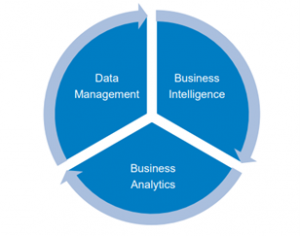
Figure 3: The three stages of the Decision Support process
Data management is related to accessing data that are scattered in various repositories throughout the organization, and performing the so called ETL process (Extract – Transform – Load) in order to improve their quality (cleaning process), transform them in a way that will make them suitable for decision support and finally load them in the data warehouse, the database of the Decision Support System (Figure 4). The data management process is usually done by the so called data engineering / data management professionals.

Figure 4: The Data Management Process for Decision Support
(Adapted from images available at www.srisubha.co.za/solutions/etl-services/)
Business Intelligence
Business Intelligence (BI) is related to reporting and visualization of data to find patterns, trends and associations that will help the analyst in the modelling process (business analytics) and also to find errors in data that need curation, see Figure 5. The EDA (Exploratory Data Analysis) process is usually supported by BI. Also BI is used to create dashboards with KPIs (Key Performance Indicators) to disseminate the information explored by the analysts to the whole organization and more specifically to the business users who are usually the decision makers. The tools that are used during the BI process are Standard Reports, Ad – Hoc Reports, Multidimensional Reporting and Alerts. It should be underlined that Business Intelligence reveals what happened in the past and is conducted by the so-called Reporting and Visualization Analysts or Business Intelligence Consultants.
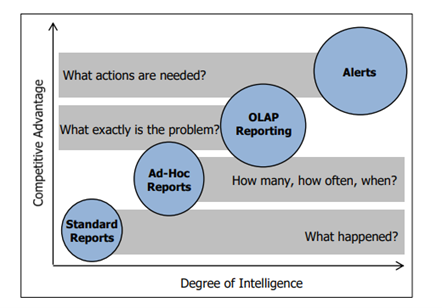
Figure 5: Business Intelligence
Business Analytics
Business Analytics (BA), as defined by the Institute of Analytics in 2010, is the broad use of data and quantitative analysis to support the business decision-making process. BA comprises of mathematical and statistical techniques applied to data to generate insights and aid decision makers. Business Analytics is the union of three subfields, Business Statistical Intelligence, which has its roots in statistical science, Business Modelling Intelligence, which has its roots in Operational Research/ Management Science and Business Domain Knowledge that has its roots in Business Administration. It should be underlined that BA tries to predict the future and explain why something happened in the past and is conducted by the so-called Business Analytics Professionals.
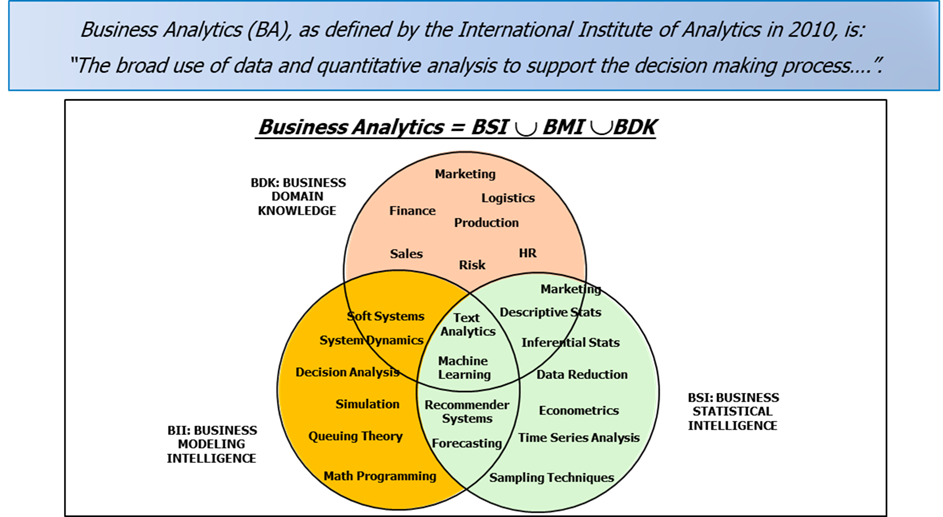
Figure 6: Business Analytics (1 / 2)
The main techniques used in Business Analytics processes are traditional statistical analysis, forecasting, machine learning and optimization, and their extensions such as computer vision, social network analysis, text analytics, recommendation systems etc. As an organization moves in the Business Analytics line, presented in Figure 7 below, gradually using the four main techniques mentioned above, its degree of intelligence and hence its competitive advantage increase.
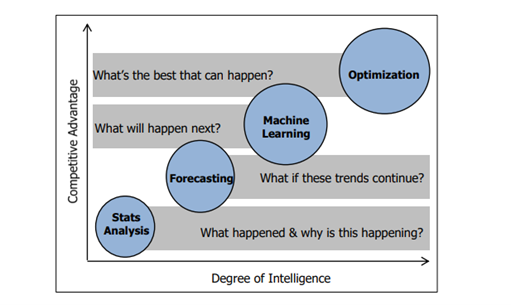
Figure 7: Business Analytics (2 / 2)
Artificial Intelligence
Artificial Intelligence (AI), a term introduced in the middle of the 20th century by Alan Turing and John MacCarthy, is the field of science that is occupied with transforming machines in a way so they can think and make decisions more intelligently than human beings, mainly by learning from huge amounts of historical data. At the heart of AI we can find Business Analytics which, as it was previously mentioned, consists of mathematical and statistical techniques such as Machine Learning, Natural Language Processing, Forecasting and Evolutionary – Optimization Algorithms. At this point it should be clarified that Data Management and BI are not considered part of AI directly, but are very important stages of its process since they are prerequisites for applying Business Analytics which as it was mentioned are the cornerstone of AI.

* DL = Deep Learning, ML = Machine Learning, RL = Reinforcement Learning, EA = Evolutionary Algorithms, NLP = Natural Language Processing
Figure 8: Artificial Intelligence (AI)
In the recent years, due to the increase of computing power and the massive data generation, the field of Artificial Intelligence has evolved rapidly and it is used extensively as a tool to support Business Decision Making. Though the future of AI is ahead and many more applications and usages are yet to come. In Figure 9 below some of the most important business applications of Artificial Intelligence are presented, that cover the full range of all the functions of modern organizations such as Marketing, Finance, Sales, Human Resources, Operations and Risk.
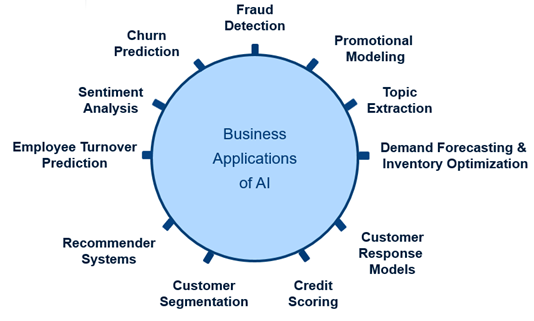
Figure 9: Business Applications of Artificial Intelligence
Artificial Intelligence can be classified into two main categories: a) Weak AI, also known as Specialized AI or Narrow AI and b) Strong AI, also known as Artificial General Intelligence. All the AI applications that exist nowadays are weak AI, which, despite its name, is far from weak.
Weak AI focuses on a specific, dedicated task, and is designed to execute it better, i.e., more accurately and faster than a human being. An indicative task that is supported by weak AI is credit scoring, the process performed by credit granting institutions to determine the creditworthiness of an individual or a business, helping the business users and the management teams decide whether to grant or reject credit. Another application supported by weak AI is churn prediction, a process helping businesses predict which customers are likely to attrite, i.e., cancel the subscription to a service or cancel the cooperation with the organization. Such processes are critical for organizations belonging to saturated markets (e.g., telcos, banks, insurance sectors) since they help them retain their market share as acquiring a new customer normally costs more than retaining an existing one.
Strong AI aims to create intelligent machines that are indistinguishable from the human mind and have a self-aware consciousness and the ability to solve problems, learn, and plan for the future. Just like young children, machines powered by strong AI would have to learn autonomously through interaction with the environment, constantly progressing and advancing their abilities over time. While AI researchers in both academia and industry focus in the creation of machines powered by artificial general intelligence (AGI), this task remains in theory; Applications of Strong AI appear only in science fiction movies, where robots and machines act autonomously and are attacking the human race. In recent years we have experienced the creation of the so-called Large Language Models / Language Learning Models (LLM) such as Chat GPT created by Open AI and Bert created by Google. These AI models use deep learning techniques (a category of advanced mathematical and statistical techniques) that learn from huge amount of historical data to generate content, e.g., a recommendation letter, a university dissertation, an image or a video. This kind of AI is still weak Artificial Intelligence, but we can say that is a big step towards strong Artificial Intelligence.
In Conclusion
Artificial Intelligence is a very promising tool for supporting Business Decision Making and its proper use can help private and public organizations operate more effectively and more efficiently. Though, it should be used with significant caution since its usage arises many issues such as questioning of fairness in the decisions, algorithmic bias, lack of decision explainability and justification, ethical concerns, and many more.
References
Baesens, Bart (2014), Analytics in a Big Data World: The Essential Guide to Data Science and its Applications, Wiley.
Blanchard R. et al (2020), Optimization Concepts for Data Science and Artificial Intelligence Course Notes, Cary, SAS Institute Inc
Davenport, Thomas (2018) ‘From analytics to artificial intelligence’, Journal of Business Analytics 1(2) pp 1-8.
Gorman, Michael F., Klimberg, Ronald K. (2014) ‘Benchmarking Academic Programs in Business Analytics’, Interfaces 44(3) pp 329-341.
IBM (2024), What is strong AI? Available at: https://www.ibm.com/topics/strong-ai#
Kattamuri S. Sarma (2017), Predictive Modeling with SAS Enterprise Miner: Practical Solutions for Business Applications, Third Edition. Cary, SAS Institute Inc.
Klimberg, Ronald & Miori, Virginia. (2010). ‘Back in Business’. OR/MS Today, 37 pp 22-27.
SAS Institute Inc (2018). Artificial Intelligence for Executives Integrating AI Into Your Organization, Cary.
SAS Institute Inc (2018). The Machine Learning Landscape: A quick guide to the different types of learning, Cary.
Statista (2024), Volume of data/information created, captured, copied, and consumed worldwide from 2010 to 2020, with forecasts from 2021 to 2025. Available at: https://www.statista.com/statistics/871513/worldwide-data-created/
Zaras, Andreas (2023), Business Forecasting Course Notes for the MSc Data Science, American College of Greece.
Zaras, Andreas (2012), ‘Design and implementation of Business Intelligence infrastructure: The case of a DSS for providing insights about the past, current & future pricing conditions in a countrywide fast moving consumer goods market’, Proceedings of the 23d National Conference of the Hellenic OR Society, Athens pp 14-19 (ISBN: 978-960-87277-8-6).















